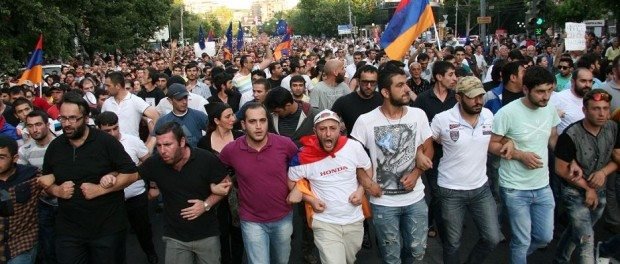After occupying a capital avenue for two weeks earlier this summer, Armenia’s #ElectricYerevan protest against an electricity price hike dissipated without declaring victory. But it still managed to achieve more than its stated goal.
Thanks to protesters who acted more like investors than gamblers, the Armenian Summer boosted sovereignty, democracy, and civil society in what once was the smallest of Soviet states. Protesters remained peaceful, persistent, and realistic, even after police used force to remove them on June 23.

The evening before, thousands had marched toward the Presidential Palace on Marshal Baghramyan, the Yerevan avenue that honors a World War II commander and houses all branches of government. After the police stopped the unsanctioned march, many protesters decided to stay on the street until their demand was met.
The next morning’s use of water cannons and forced detentions backfired, prompting thousands more to join the protest. For two weeks they danced, debated, swept the street, and refused a meeting with the president. Most importantly, they stayed true to their message.
Within days and despite the prime minister’s announcement that the rate increase was inevitable, President Serge Sarkisian suspended the Russian-owned power supplier’s requested price hike until an audit could be performed by an independent firm. While the populist action elicited neither surprise nor praise, Moscow’s unprecedented pandering to Armenian protesters became the most unexpected development.
After initially signaling displeasure over the somewhat anticipated protests—as evidenced by Russian TV reports accusing protesters of violence and mimicking Ukraine’s pro-western movement—Moscow took a number of initiatives that gave a rare boost to Armenian sovereignty. However, the concessions only came after protesters consistently challenged Russian journalists’ narrative; confronting one, giving a compelling account of economic injustice to another, and demanding a halt to comparisons between #ElectricYerevan and Ukraine’s Maidan.
Within days, Russia’s minister of energy traveled to Yerevan and publicly accepted proposals from Armenia’s president on auditing the Russian-owned electric provider. As an additional boon to Armenian sovereignty, Moscow agreed to let Yerevan authorities prosecute an Armenia-stationed Russian soldier, who is accused of massacring a Gyumri family, despite having previously ignored such demands. Soon thereafter, the Russians also granted a large loan to Armenia, a CSTO military ally, for the purchase of new weaponry amid ongoing concerns over Moscow’s arms sales to Armenia’s archenemy Azerbaijan.
In short, Armenian protesters compelled Russian President Putin to respect Armenia’s sovereignty—something that even Washington’s sanctions have been unable to achieve vis-à-vis Moscow’s treatment of other post-Soviet countries. This was achieved not by calls for regime change or global realignment, but through adamant yet peaceful opposition to a price hike stemming from factors like corruption, mismanagement, and devaluation of the Russian ruble due to Western sanctions.
The protesters—often young, educated, and middle class—clearly realized the futility of vague anti-government protests, as well as the geopolitical risk of directly challenging Kremlin’s tight grip on Armenian politics. They also demonstrated what democracy looks like. In response to police demands, #ElectricYerevan initiators, who refused to be called leaders, consistently stated that they would only make decisions after consulting with protesters. Nevertheless, solidarity was not always solid. Going into the second week of protests, there were disagreements over the future of #ElectricYerevan.
Despite expected shortcomings in sustaining a populist protest, the Armenian Summer brilliantly demonstrated how ordinary citizens could give unaccountability a cold shower without jeopardizing stability. The faded movement’s message that tolerance for corruption is limited continues to reverberate. In an unprecedented slap to a government loyalist, Armenia’s authorities recently arrested the son of an appointed governor infamous for violent behavior.
Whether the wave of change prompted by #ElectricYerevan will positively impact the economic monopoly, elections, or justice system is yet to be seen. However, even as it stands, the Armenian Summer is an inspiring example of how issue-driven civil resistance can transform politics.


Simon,
This may not be the best way to contact you….but it’s how I found you (I think) on the Internet….Carole Newman, here. Do you remember me?? Your dad gave me a little painting he’d done…and I have it still, displayed in my living room…I think of him each time I dust it…or look at it. Just wanted to let you know that your Dad was important to me…and I’m glad to have met him…
Hope all is well with you
Carole